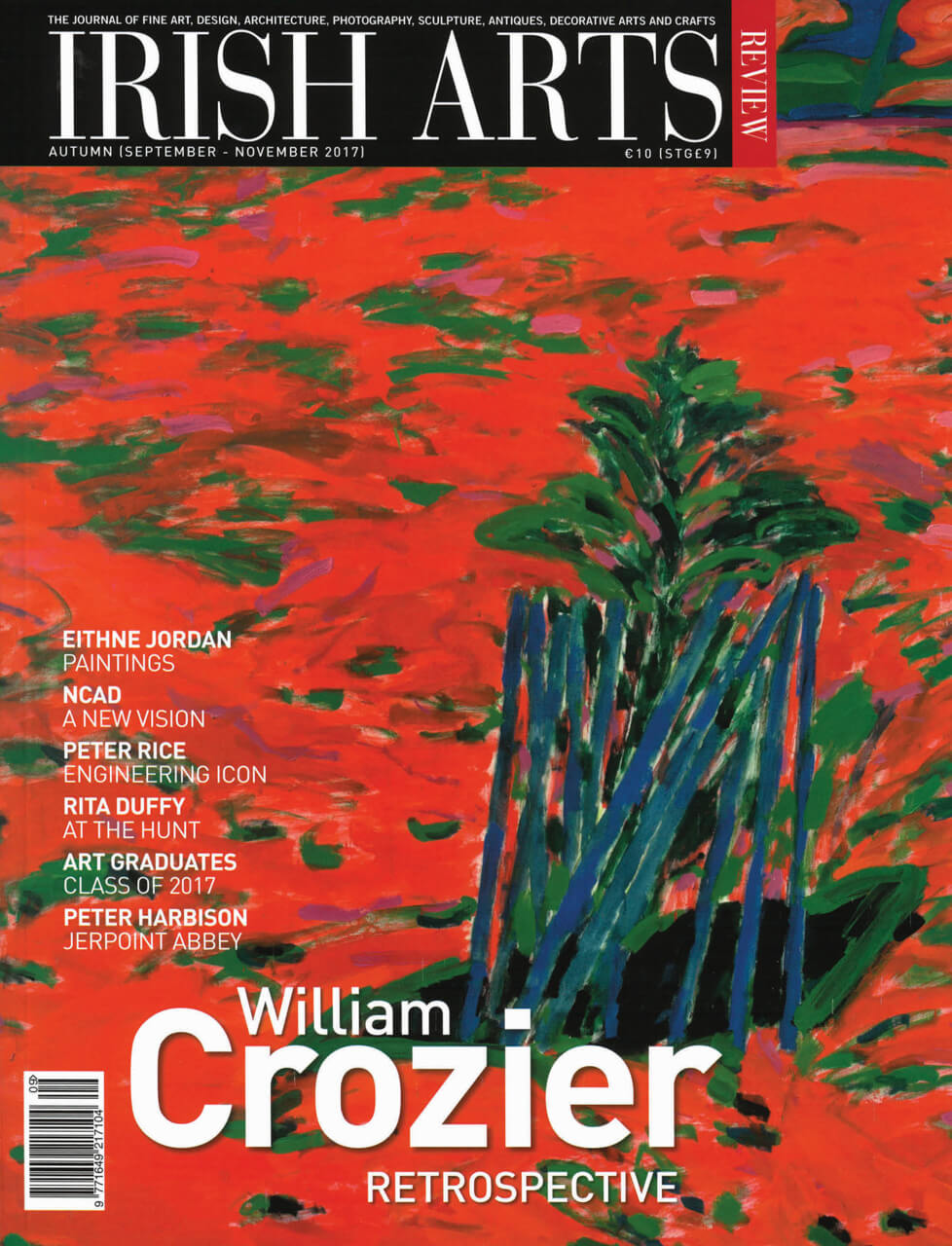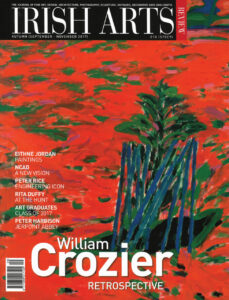

Stephanie McBride examines the aesthetic of photographer David Farrell whose method of revisiting his subjects and themes allows for a sustained critical engagement
Despite or even because of its democratic reach, photography often has a slippery status as the poor relation of the visual arts. But significant initiatives that recognise and support photography in Ireland include special commissions for photography and the Curtin O’Donoghue prize – of which David Farrell was twice winner in 2012 and in 2016. His While a Building Sleeps was also featured in the 2006 Central Bank and Financial Services Authority of Ireland’s special photography commission, The Bank, alongside work by Michael Boran and Michael Durand.
Among the many powerful images in that project, Farrell’s startling photograph of the Central Bank’s deserted boardroom is an outstanding play of light and reflections, like a ghostly powerful presence over the night-time city (Fig 9). Shot within the opulent glass cathedral of finance, this prophetic image carries Farrell’s metaphoric signature and links through to his sustained engagement with rural landscapes. The Central Bank’s recent relocation to the site of the former Anglo-Irish Bank in Dublin’s former docklands has attracted much comment; Farrell, painter Brian Maguire and others have suggested that the building should have been left as a shell, Ozymandias-like, a monument to hubris and the fallout from unregulated speculation. But the newly clad edifice has covered up – literally and symbolically – the spectral shape of the toxic bank’s unfinished building. Such erasures of history and memory are central to Farrell’s vision, in his archival excavation and reflexive commentary on contemporary Ireland.
One direct consequence of the banking collapse and the vestiges of the Celtic Tiger’s demise was a plethora of unfinished housing schemes that blight the Irish landscape, which Farrell and others have photographed. His ‘An Archaeology of the Present‘ captures these ruins and wastelands for future excavation as it were, as history in the making. In The Waterways, Keshcarrigan (2012) (Fig 8), the entire image resonates with a biblical, apocalyptic energy: a rough stony foreground and three solid concrete columns lead the eye into an unfinished estate of gaping holes, abandoned and desolate houses, more columns and half-dug foundations under a menacing sky.
Farrell’s practice of cool/late photography has a further, more nuanced edge in that many of his projects are ongoing, extending well beyond publication of the initial work. His interest in ‘elusive rather than decisive moments’ is at the core of one of his best-known series, Innocent Landscapes. Here he photographed – and keeps returning to – the ‘sites of the disappeared’: the bogs and fields where bodies are said to have been buried by the IRA during the Troubles. Farrell sees the bog as ‘a memory bank, the witness of history and trauma’.
In Innocent Landscapes his framing upturns expectations: it prompts a gradual realisation that, in an otherwise picturesque image of Templetown beach, we are seeing a crime scene, as we register the police tape marking off parcels of land. Similarly, Achill Henge (2014) is at first glance a traditional West of Ireland landscape, emblematic of the idyllic pastoral (Fig 1). Then the eye is drawn to a huge man-made structure jutting up from the land – literally a monumental response by one local citizen to the Celtic Tiger’s failures. The official desire for selective amnesia is no longer tenable when ordinary people and photography confront these follies of global and local excess.
The official desire for selective amnesia is no longer tenable when ordinary people and photography confront and continually bring us back to those follies of global and local excess
Given Farrell’s emphasis on memory and history, his collaboration with the RHA as part of the 1916 commemorations was especially incisive. National commemorations usually tend to steer or corral public responses into a consensus about political and economic aims, boiling them down into an intellectual and moral unity and ironing out any troubling contested elements in the subsequent festivals of flag-waving and ribbon-cutting. In the RHA show and catalogue of Farrell’s thirty-year project of published and previously unpublished work – called Before During After ‚Ķ Almost – the very title words defy closure or anchorage. Farrell’s deliberate stylistic mix and the absence of captions works as an antidote to a classic overarching narrative ‘evenness’ or oversimplified resolution.
Images from his archive also slip fixed historical moorings. Visual echoes and repeating tropes give a sense of a circular narrative of failed, ragged or uncertain change, of fading remnants of previously powerful institutions, of repeated and latent tensions. These images include Orristown (2000) part of the ‘Innocent Landscape‘ series (Fig 4), with its verdant vortex drawing all into it; or Dublin (2015), showing a painted flat white roundabout with arrow signs in an endless circular pattern; and Kilmainham (2004) – a name resonant in national memories, in which an ivy growing in rough ground has been cut back, yet traces of former growth are still visible on the green corrugated fencing, worn and etched into the grooves of the fence (Fig 3). Ghostly branchworks, suggesting a nuanced metaphor for Irish experiences in what Farrell has called a ‘failed Republic’ where craven piety, acquisitiveness, unfettered greed continue to play out in the ruts of history.
It would be misleading to read Farrell’s work as darkly pessimistic throughout. His visual narratives probe and question rather than crudely define. In Port Laoise (2010) (Fig 5), a small window hosts a tricolour and a cheerful clutch of balloons in a makeshift shrine to some Irish celebration or other. In Farrell’s photographic vision, this quirky window display suggests just how tentative, contingent and indeterminate Irish identity is. It is as authentic as the Boy, sometime in the early 90s with his serious, face-painted Batman mask (Fig 6)
Nature with its vast timescales begins to lay claim, repair and transform the devastation wrought by human activity and violence
Farrell’s images of landscapes, upturned and excavated in a search for missing bodies, are sites that, through his continual return, see a renewal of growth. Nature with its vast timescales begins to lay claim, repair and transform the devastation wrought by human activity and violence. In what Farrell calls his small acts of memory, some form of future becomes visible.
Farrell’s engagement with the landscape as witness to and bearer of the ravages of history and humanity extends to his current work (originally part of the Landscape at Risk project) at the Lido di Ostia (Fig 7). Once the ancient port of Rome, Ostia is now a neglected, marginalised suburb, whose inhabitants feel written off ‘in the Shithole of Satan’, and which he refracts through his expressive, political lens. In this Anthropocene age, despite columns of data and directives, people and places are increasingly silenced, neglected or ignored. Farrell’s images remind us of this with a disturbing eloquence. Never was it more urgent.
Stephanie McBride is a writer and critic.



